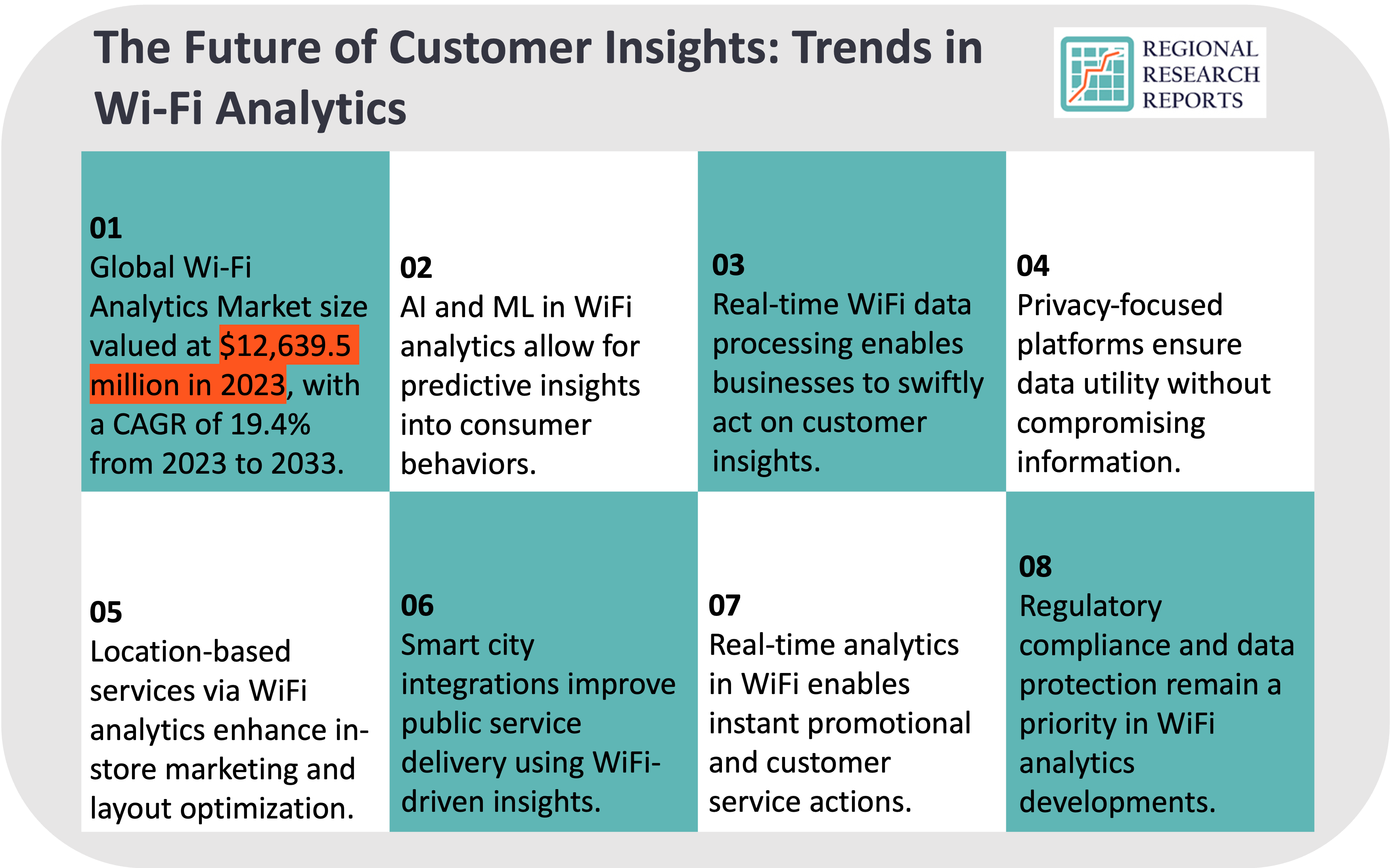The Future of Customer Insights: Trends in WiFi Analytics
Release date: 06-11-2023SKU: Regional Research Reports
Release date: 06-11-2023SKU: Regional Research Reports

The market for Wi-Fi analytics has burgeoned with technological advancements and a growing appetite for deep consumer insights. As businesses crave a deeper understanding of customer preferences and behaviors, Wi-Fi analytics stands out as a tool for illuminating the customer journey. This blog delves into the latest trends in Wi-Fi analytics, offering a comprehensive analysis of its future market trajectory.
Introduction to Wi-Fi Analytics
Wi-Fi analytics involves collecting data from customers' use of a wireless internet network. By analyzing this data, businesses can gain insights into how customers interact with their physical spaces, much like website analytics has revolutionized the understanding of online behaviors.
Wi-Fi analytics involves the collection and analysis of data generated by Wi-Fi networks, enabling organizations to gain valuable insights into user behavior, network performance, and location-based data. The market has witnessed significant expansion due to the growing reliance on wireless technologies across various industries. Businesses are increasingly embracing digital transformation, necessitating advanced analytics tools to optimize operations and enhance customer experiences. Wi-Fi analytics plays a pivotal role in this transformation. With the surge in mobile device usage, understanding user behavior and preferences has become essential. Wi-Fi analytics provides businesses with valuable insights to tailor their services and offers. The retail and hospitality sectors are using Wi-Fi analytics to track foot traffic, personalize customer experiences, and deliver targeted promotions, enhancing customer satisfaction and loyalty. The COVID-19 pandemic accelerated remote work adoption, driving the demand for reliable and secure Wi-Fi connections. Thus, Wi-Fi analytics helps organizations ensure a seamless remote work experience for their employees. Wifi analytics enables the organization to use the information available through the wireless network to make better decisions about physical space. Wifi has evolved as one of the most widespread and versatile modern in-store retail analytics technologies. E-commerce businesses use online marketing analytics tools to monitor customer navigation data through company websites. The collected data yields insights and makes decisions to increase business revenue.
Current Market Landscape
According to the Regional Research Reports, the Global Wi-Fi Analytics Market size is estimated to be USD 12,639.5 million in 2023 to USD 73,927.3 million by 2033, exhibiting a CAGR of 19.4% from 2023 to 2033. An increased focus on customer engagement, operational efficiency, and enhanced customer experiences drive this surge.
Integration with Marketing Strategies
Businesses are leveraging Wi-Fi analytics to develop targeted marketing campaigns. By understanding customer traffic patterns, dwell times, and frequented areas within a store, companies can tailor their marketing efforts to increase conversion rates.
Enhancing Customer Experience
Wi-Fi analytics enables businesses to optimize their services by analyzing the volume and movement of their customers. It's used in various settings, including retail outlets, hospitality, airports, and smart cities, to improve customer satisfaction.
Key Trends Shaping Wi-Fi Analytics
Several key trends are currently shaping the Wi-Fi analytics space, including:
Detailed Market Analysis
To understand where Wi-Fi analytics is headed, we must delve deeper into these trends and the factors driving them.
Artificial Intelligence and Machine Learning in Wi-Fi Analytics
Artificial Intelligence and machine learning are at the forefront of advancing Wi-Fi analytics. By applying these technologies, Wi-Fi analytics can predict future consumer patterns more accurately. AI algorithms can process massive datasets to identify trends and even anomalies in user behavior, offering businesses actionable intelligence to craft customer experiences that are personalized and engaging.
Impact of Location-Based Services on Wi-Fi Analytics
Location-based services are revolutionizing how customers interact with physical spaces. Wi-Fi analytics is vital in this space, allowing businesses to send targeted offers to customers based on their store locations. This technology also supports better layout planning and inventory management based on heat mapping of customer movements.
Privacy and Compliance
Privacy regulations such as GDPR in Europe and CCPA in California have put consumer data privacy in the spotlight. Wi-Fi analytics platforms are now more focused on data protection, ensuring insights are gleaned without compromising personal information. This requires a delicate balance between data utility and privacy, a significant focus for development in this technology.
The Power of Real-Time Analytics
The ability to process and act upon data in real time greatly benefits customer service. Real-time analytics allow businesses to address issues as they occur, create instant promotions, and even alert staff to important customer needs. The agility afforded by real-time analytics gives businesses a significant competitive edge.
The Integration with Smart City Initiatives
As urban spaces become 'smarter', Wi-Fi analytics plays a critical role in understanding and managing the flow of people through public spaces. It can help plan events, emergency services, and even urban planning. Smart city initiatives around the globe are incorporating Wi-Fi analytics for these purposes.
Challenges and Considerations
Despite its growth, the Wi-Fi analytics market faces challenges. Data accuracy, network security, and interoperability between technology platforms require attention. Additionally, the market must navigate the complex terrain of varying global regulations on data collection and use.
Case Studies and Success Stories
Several businesses have already witnessed success with Wi-Fi analytics. Retail chains have optimized store layouts, airports have reduced wait times, and event venues have improved crowd management—all through insights provided by Wi-Fi analytics.
Conclusion and Future Outlook
The future of Wi-Fi analytics is bright, with expansive growth anticipated in the coming years. By harnessing the power of AI and ML, respecting privacy, and delivering real-time insights, businesses will continue to uncover the profound impact Wi-Fi data can have on their bottom line. As the market evolves, those who embrace these trends will lead the way in creating enhanced customer experiences that are both profitable and privacy-conscious. Our latest report on the "Wi-Fi Analytics Market Size, Share, and COVID-19 Impact Analysis by Component, Deployment, Application, Industry, Regions, Company Market Share, and Regional Forecast, 2023-2033" is concluding in the following pointers -